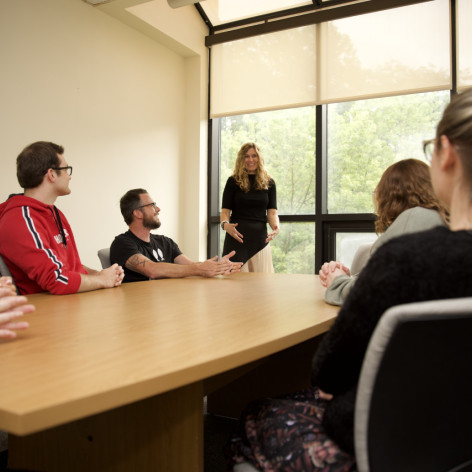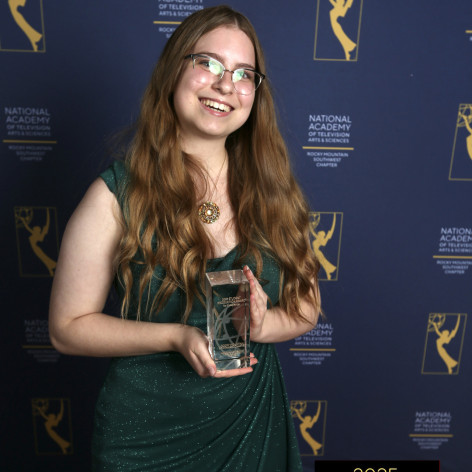The Race Not Yet Run
In her three years at Huntington University, Molly Shirey has twice been named an NAIA Scholar Athlete, and last November, she qualified for the NAIA National Outdoor Track and Field Championships in the marathon.
But as her final year at HU came to a close in May, there was still one goal that Shirey had not accomplished running a meet on her home track.
"It's kind of like training for a marathon, but you go to the closet and all that you have are flip flops," Shirey said of the condition of the track that has kept the team from using it for meets.
In 1990, a renovation to the Merillat Physical Education and Recreation Complex made the facility state of the art. Now, 21 years later, the facility has not changed much even though enrollment has since doubled.
Today, students and professors need more space for exercise and weight-training as well as new classrooms and fitness labs. The outdoor track must be renovated, and all-weather turf needs to be added to the soccer field to accommodate sporting and intramural events. And the sporting teams need additional hardwood playing surfaces for practice.
Out of these needs came a $9.5 million construction and renovation project through Together: The Campaign for Huntington University.
Some work has already begun. The bleachers in the varsity gym were replaced in 2010 to resolve some mechanical problems. Fans have welcomed the new seating, but much work remains to be done.
'�The best you can be'
In the years since the 1990 renovation, hundreds of students have sought Huntington University for its academic prowess in its recreation, physical education, sports ministry and exercise science degree programs, not to mention the thousands more who have used the MPERC for training, sporting events and general wellness.Three years ago, one of those students was Molly Shirey. She was a small-town girl looking for a small-town school with a top-notch education. Shirey had a love for running and a naturally bubbly personality that attracted her to an interpersonal field. Applied exercise science combined those loves for her.
For Shirey, being at Huntington University has been like running a race. She paces herself through the steps, carefully marking her strides to the finish line.
It's a technique she knows well, having paced her way through track and cross country competitions during her three years at HU.
"I started running and then got my sister running and we got our mom running," Shirey said. "Running has been very much a family thing."
In her time at HU, Shirey has shined as a star on the track team all the while maintaining a career 3.7 GPA. She graduated this May with a Bachelor of Science degree in applied exercise science.
"The best part about the exercise science program is the incredible way in which the professors allow us to take responsibility," Shirey said. "We are taught and equipped, but then expected to go out on our own and challenge ourselves as we put the knowledge to use."
Shirey's degree will open a wide variety of future career paths. Many exercise science majors become personal trainers or work in physical rehabilitation. Shirey's knowledge of human anatomy and her deep commitment to serving others have prompted her to consider another option a future career as a mortician and funeral director.
Whatever the future holds, Shirey says she is not only becoming skilled for a profession, but is building character and self value. Overall, she said she grew as a person because of this program, despite the limitations of the facility.
"The classes that I am in require equipment and require facilities," Shirey said, explaining that sometimes professors had to work around these issues to explain some concepts. "(But) if you're willing, Huntington has opportunities for you to become the best person that you can be."
A step behind the rest
When the Merillat Physical Education and Recreation Complex was renovated in 1990, it rivaled all others in the conference, and offered better recruiting opportunities for the college.Two decades later, however, other colleges' athletic facilities have matched or surpassed what the MPERC offers. Recruiting efforts have been hindered as a result. The comparative lack of equipment and space has required professors to improvise in the way they teach some classes.
"(Recreation and) athletics are a big part of any university," said Dr. Matthew Ruiz, assistant professor of exercise science. "Every year, I think more students are slipping through the cracks."
Ruiz, Professor Connie Updike and Dr. Jody Davenport said that the strength and conditioning classes are the most difficult to teach right now because of the limitations of the facility.
"(Improvements to the fitness areas) would immensely benefit our curriculum," said Davenport, assistant professor of physical education. "And the entire student body," added Updike, associate professor of recreation management. "And that's what would bring more students in."
Creating opportunities
Matt Gerlach, a 2007 recreation and sports ministry graduate, would never say that his HU education was in any way lacking because of the current condition of the MPERC. In fact, he was more prepared than many other job candidates after graduation.Yes, he wished that there would have been more space in college for practicing or more equipment available for weight training, but that didn't stop him from pursuing his career.
In 2009, Gerlach was named the minister of recreation at the First United Methodist Church in Panama City, Fla.
"I get new faces into the church and ultimately have them hear about the word of Jesus Christ," he said. "It's a neat thing. It's a neat opportunity for our community."
The sports ministry degree at HU is a unique program. It combines the foundations of recreational leadership, administration and programming with biblical truths, evangelical theology and psychology.
For Gerlach, it allowed him to walk into the interview for his current job and wow his future employers.
"There was a vast difference between what others were saying and the knowledge that I had of facilities and equipment and training," he said. "It's making the best of what you have or what you're coming into."
Fielding dreams
Every student has dreams. Some involve planning for future careers like Stanley "Trey" Sands, a senior physical education major, who wants to be a middle school P.E. teacher. Others involve making it to the national stage like Todd Fiedler, a senior applied exercise science major, who wants to be an Olympic athlete in the javelin some day.Huntington University invests in its students to help them reach their goals whether that is academically or athletically.
"I would think about what those NCAA commercials say: (Just about all college) athletes are going professional in something other than sports,'" Fiedler said. "I see kinesiology as being the next thing to invest time and money into."
"I think that people will see that this (project) is important to Huntington and be drawn to it," Shirey added. "I think it's going to encourage a new wave of healthy activity."
Together, building a future
The MPERC has seen its share of ups and downs over the years. It's grown, been renovated, adapted and modified to meet the needs of an ever-changing generation of students.And that process will continue.
The $9.5 million Together campaign project aims to address the needs of the facility. And even though the recession has slowed fundraising efforts, the university is studying how interim steps can be taken to complete the many projects as funding becomes available. Already, plans are in the works to resurface the track in summer 2012.
"This campaign is about more than bricks and mortar. It is about helping students to realize their dreams," said Dr. G. Blair Dowden, president of Huntington University. "It is about planting seeds of knowledge, inspiration and faith in their lives. And it is about growing together as a Christian community."



